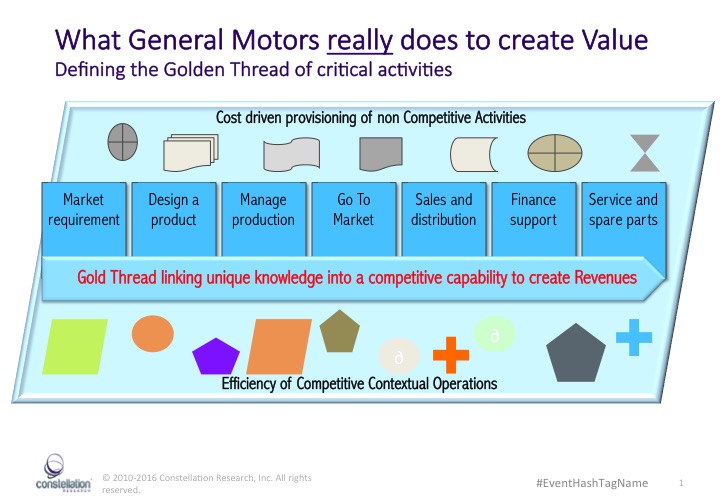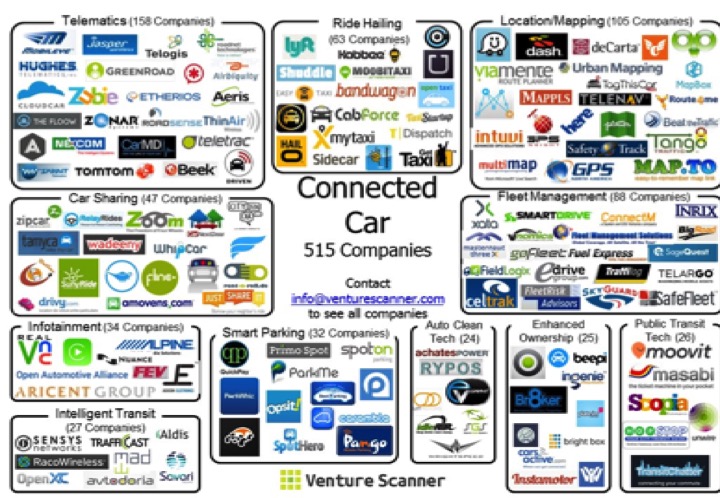To exist at all, let alone prosper any Enterprise has to create something of tangible value in the form of a proposition that will match buyers’ requirements. Digital Markets, by definition, are based on new value propositions, mostly around services more than products, a point exploited by new entrants. Recent events have shown how these circumstances are forcing existing enterprises into competitive re-evaluation of their value proposition, and Go To Market strategy.
The maturity of many current Markets has lead to relative low levels of Product innovation, and a stronger focus on finding competitive advantage through automating key processes and cost reduction strategies using IT. Increasingly non-core activities, which are non-differentiating, are being outsourced, a trend often started by IT**(see footnote), but now including Business functions such as Invoicing. The goal is to focus management time, and investment, on the critical business activities to create and sell the Products with maximized competitive differentiation.
The impact of the Internet and the Web, have forced Enterprises to develop and extend their traditional sales and marketing activities to meet changes in the expectations of customers, culture, and market places. Though these may have seemed to be major changes, or even transformations, in almost all cases they are extension of the existing core value proposition and products.
The Digital Economy creates entirely new Market places with new value proposition that result in a transformation to creating value and re-occurring revenues from Services as opposed to the one time invoice of a product. Enterprises must redefine what is the value to be created and from this what are the core activities that must work in an optimized chain of activities.
It used to be popular for Business Schools to refer to the ‘Golden Thread’ to define the coherent chain of critical activities spanning the Enterprise to create unique Business propositions/values. As an example in the case of General Motors the common activity description ‘GM makes cars’ misses defining General Motors Golden Thread. The reality is that GM competes by using its expertise in locating market niches, then designing and marketing a specific car model to compete for the selected customers; see diagram. The manufacturing of cars is carried out by an ecosystem of suppliers, or partners, providing their own specialized expertise to particular elements.

Obviously GM’s Golden Thread has, as for most other established Enterprises, been tied to selling a Product as the outcome. The same technique can be applied to define the activities that are critical to creating a Digital Markets Services outcome. GM has recognizes this and is working to develop new Golden Threads for the entirely different market around Services of the Digital Economy.
GM vision has two publically declared interlocking strategic initiatives to create high business value Services for consumption through the Digital Economy. The investment in Lyft and Driverless cars is to create new ways of providing transportation, whilst AtYourService aims to build long term relationships with ‘drivers’ to provide all their personal, individual transportation needs. Both are ‘pay by use’ subscription Services, and nether looks to sell a car as a product. Every major ‘car’ company has similar initiatives as the Industry Sector faces up to the disruptive pattern of change driven by several factors.
At the heart of this transformation is a rethink and redesign of the Golden Threads that GM must build and connect to deliver these exciting visions. The technologies that enable and deliver these Golden Threads are themselves part of the Digital Market and Services economy; namely CAAST, Clouds, Apps, AI, Services and Things. The new management generation looks to a hybrid skill base of technology and business in order to create its competitive success.
The acquisition by Samsung, known for its entertainment products, of in car entertainment specialist Harmon is a further example of a repositioning from Products to Services. Samsung Digital Services strategy focuses on providing the consumer with the Service of continuous ubiquitous personal entertainment whether in the home of on the move. Whilst Samsung may not be a direct competitor to the automotive companies it is an example of realignment within traditional market sectors introducing new competitors for a slice of the transformed Digital Services market.
The graphic below Publically published by VentureScanner.com shows the extent to which new startups are aiming to take some part of the revenues from the new connected car, or transportation market. The sheer numbers of new innovative value propositions will drive the market transformation as consumers find, and take up, new value choices.

For an established enterprise/brand to continue to its dominance into the new Digital Services Economy it has to move to completely new value proposition that offers a different experience through Services than their current product based offering. Existing customers and experiences should provide the foundation, but it will be the use of innovative technology in a new Golden Thread that is the underlying success factor.
Competitive success lies, as in the past transformations, in Business Process Re-engineering the enterprise to deliver the value proposition. Unlike the internal Back Office process revolution of ERP based client-server technologies, this time it is an external Market place driven revolution built on new technologies that will redesign the Enterprise Business model
** Footnote; The recent example of British Airways Globally visible three day outage of all passenger systems due to an IT failure is a reminder that outsourcing does not remove the requirement for a Board to understand, and retain competencies in core business operational areas.


